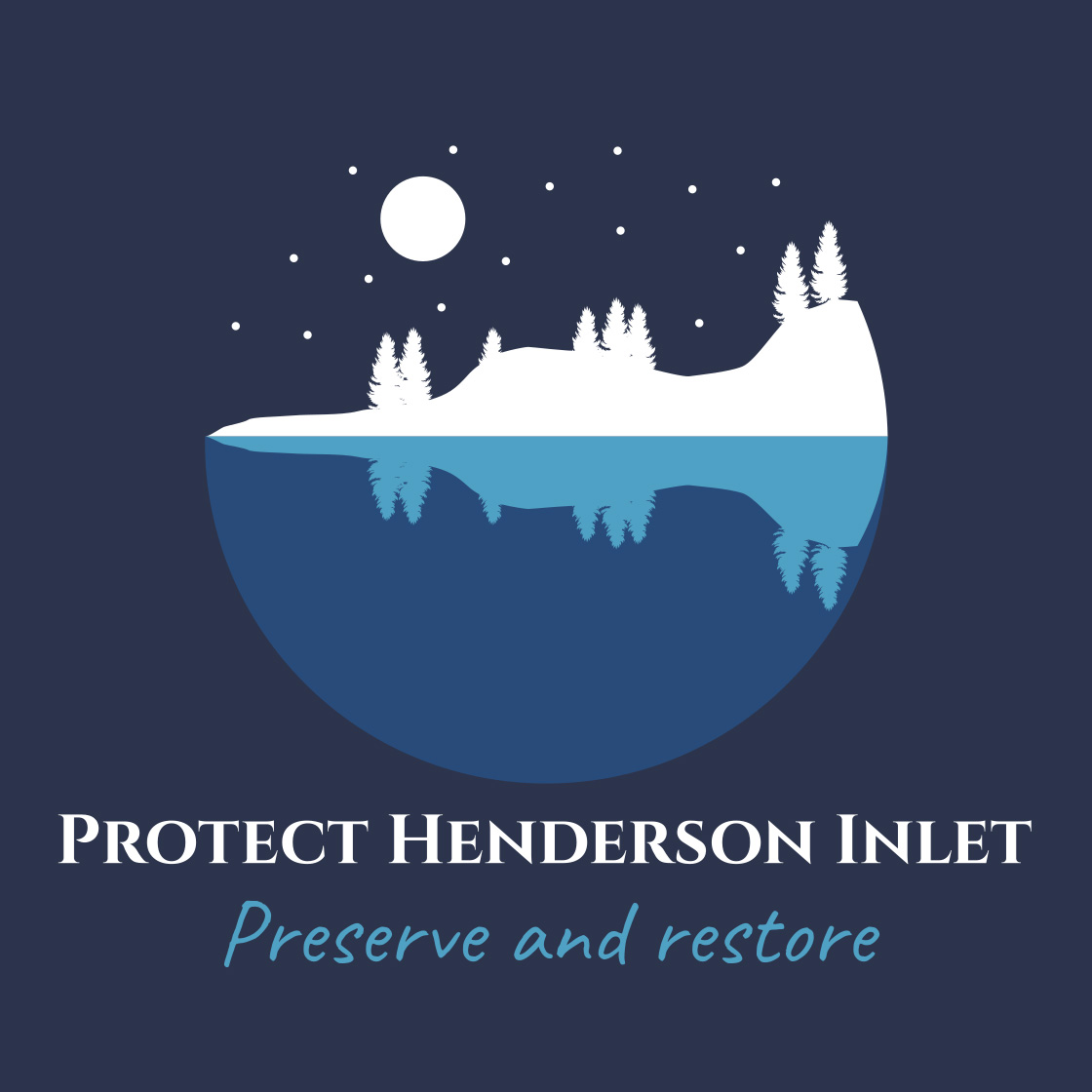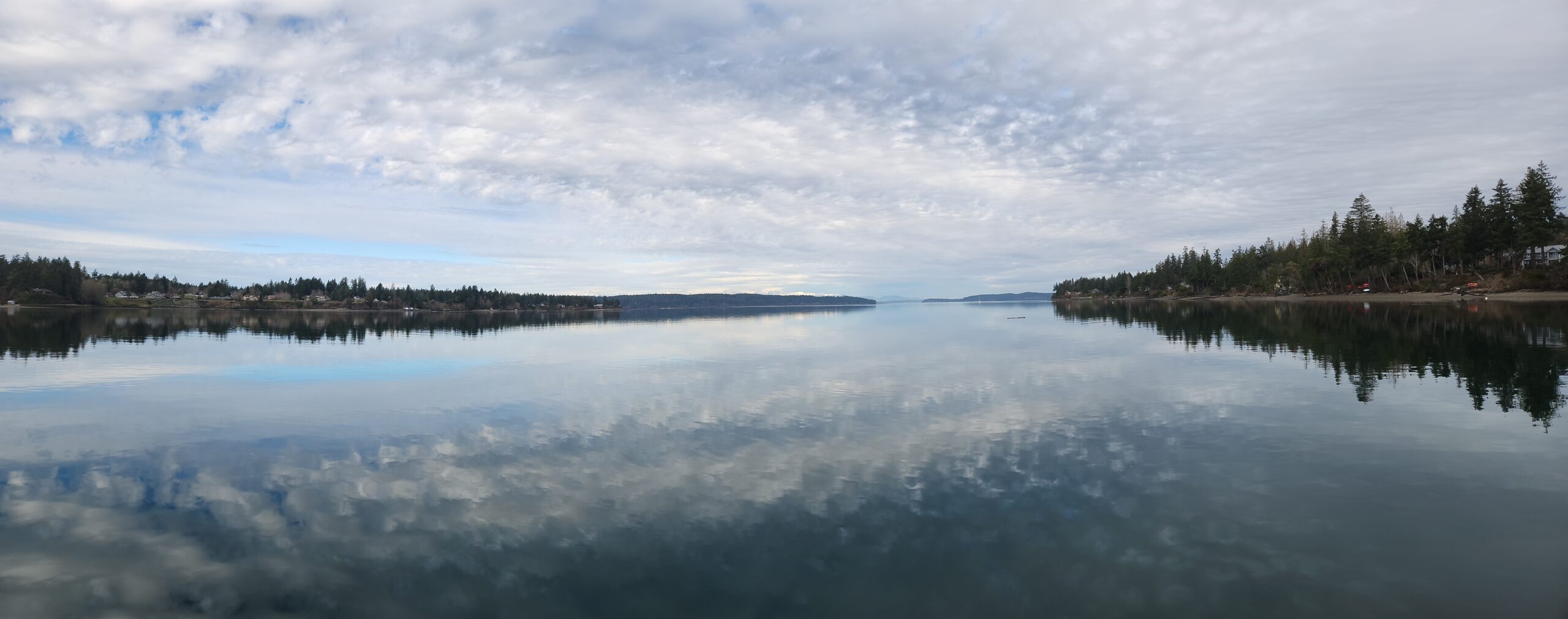21 March 2023
TO: Kraig Chalem
Community Development Center
Thurston County Washington
RE: Development project 2022103702
Subject: Potential impact of plastics
Mr. Chalem:
Please enter the following comments into the record from Protect Henderson Inlet, a non-profit environmental organization opposing geoduck aquaculture.
First, as a personal note, I’ve learned a lot about the shellfish industry since getting involved a few months ago. I would like to share some thoughts about it pertinent to the question of plastics in the marine environment, the topic of this letter.
It is important to note that there are impacts on the environment from many things that we do. For some of these, we try to offset the harm by doing something helpful elsewhere, like what the State of Washington is trying to do in selling carbon credits. PHI recognizes that shellfish aquaculture existed in the Pacific Northwest for thousands of years before the white man came to its shores. I have made friends in the modern industry and respect the hard work of small oyster growers like Perkins Family Farms and Snail Oyster Company. There are impacts from what they do, and they can and should try to mitigate those as much as possible. However, operations like theirs have been around for over 100 years, and they do provide food to the region. I think we have to accept them while protecting other areas from impact.
Our opposition is to a rapidly expanding newer form of aquaculture that is, in spite of what the industry would have you believe, largely untested and highly intrusive to the environment. Geoduck aquaculture has only been in existence for less than 20 years, only 3-4 cycles of planting, and is without any long-range studies of cumulative impact. Furthermore, geoduck aquaculture adds little to the local economy – virtually no food, largely low paid jobs, few taxes, unsightly installations, and potential genetic risks to native geoduck stocks in the same way that hatchery salmon have affected wild salmon. The only reason for geoduck farming to exist is the private making of money. Taylor Shellfish could do much to mitigate the impact of their highly profitable geoduck farms if they would.
There is a pressing need to find an alternative to filling the Sound with plastic, and Taylor should use some of its profit to that end. I spoke to Bill Dewey of Taylor Shellfish about this at the UW sponsored Shellfish Growers Conference at Alderbrook Lodge in March 2023. He asked me what problem I had with geoduck farming. I named several things, but first was “plastics.” We had a frank discussion of their past efforts. I hope that they are considering taking another look.
The shellfish industry argues that “Plastic Aquaculture gear is not a threat to Puget Sound” in a paper submitted to the Thurston County Planning Commission during the commission’s review of the Shoreline Master Plan in 2021. A copy of that document is available for review.
This paper makes many false and misleading statements and is reviewed in detail here. Each of the “Items” listed below is a false statement made in that paper written by Ramboll Environ US Corporation of Seattle Washington for Taylor Shellfish.
Item 1.2 – “Aquaculture operations are not a significant source of marine debris.”
Aquaculture is a huge source of marine plastic in the environment and the use the term “debris” is misleading. This plastic is intentionally placed, and present in the environment for many years while being used by the industry. Some of it certainly becomes debris when it is lost. Plastic impacts the environment no matter how you label it.
How much plastic are we talking about? One foot of 6 inch PVC pipe weighs 3.53 pounds. Taylor shellfish would plant 146,000 of these tubes in the beach, each about 1 foot in length, a total of 73 tons of plastic. The claim that they will recover much of it is misleading. The industry typically reuses this plastic for as many 2-year cycles as possible, and by its own admission plans to use it for decades. The County should consider that by granting this permit, they are in-fact allowing the permanent placement of many tons of plastic in the environment. All of the plastic is subject to degradation and some will certainly become debris.
The industry admits that plastics in the environment is a major problem, and cites literature about sources of plastic pollution. They are correct that terrestrial sources are the major contributor of microplastics in the environment. No argument. However, it is completely ingenuous to suggest that because indirect terrestrial sources are a major source of plastic pollution, that the county should permit the direct placement of tons of plastic in the environment. The industries’ argument here has absolutely no merit.
The industry states: “loss of aquaculture gear is already minimized.” What does this mean? They never claim to recover all the plastic, but give no data as to how much is lost. And they do lose it. Anyone who lives near an aquaculture site is used to having plastic aquaculture gear wash onto their beaches. On Otis Beach, where I live, it happens all the time.
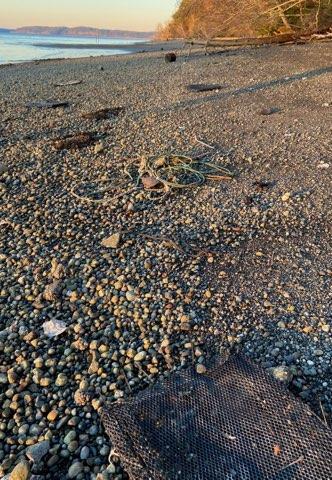
In a separate letter, I’ve already characterized the dynamic nature of the proposed geoduck site with potential for 4 foot storm waves from two directions. The industry should define “minimal”. What percent of lost tubes do they expect? In the unlikely event that they recover 99% of their tubes, that leaves approximately 1500 tubes (5,295 pounds) in the environment, which is highly significant. To the best of our knowledge, Thurston County has no plans to enforce a standard of tube recovery, nor do they have capacity for compliance assessment. It is irresponsible for the County to permit this process. Furthermore, the authors of Taylor’s pro-plastics paper intentionally mis-state the science when they say: “studies have shown that removal of marine debris is effective at mitigating the potential to create microplastics. (Andrady 2011). This is the abstract of this citation:
“2011 Aug;62(8):1596-605.
doi: 10.1016/j.marpolbul.2011.05.030. Epub 2011 Jul 13.
Microplastics in the marine environment
Affiliations
- PMID: 21742351
- DOI: 10.1016/j.marpolbul.2011.05.030
Abstract
This review discusses the mechanisms of generation and potential impacts of microplastics in the ocean environment. Weathering degradation of plastics on the beaches results in their surface embrittlement and microcracking, yielding microparticles that are carried into water by wind or wave action. Unlike inorganic fines present in sea water, microplastics concentrate persistent organic pollutants (POPs) by partition. The relevant distribution coefficients for common POPs are several orders of magnitude in favour of the plastic medium. Consequently, the microparticles laden with high levels of POPs can be ingested by marine biota. Bioavailability and the efficiency of transfer of the ingested POPs across trophic levels are not known and the potential damage posed by these to the marine ecosystem has yet to be quantified and modelled. Given the increasing levels of plastic pollution of the oceans it is important to better understand the impact of microplastics in the ocean food web. “
As you can see, the paper does not say that it is environmentally sound to permit the placement of 73 tons of plastic into the marine environment, no matter what percent of that is actually lost and subsequently recovered. Their article really is an indictment of the process of geoduck farming.
This is a typical misuse of science by the industry.
Item 1.3 – “Aquaculture gear does not break down easily to form microplastics.”
The industry does not assert that aquaculture gear does not break down – they admit that it does. “Easily” is a qualitative term. Mechanisms for breakdown are well documented, indeed clearly stated in their own references (see above). “Weathering degradation of plastics on the beaches results in their surface embrittlement and microcracking, yielding microparticles that are carried into water by wind and wave action.” These mechanisms include degradation by UV light, heat, mechanical abrasion by contact with beach substrate and breakdown by microbial agents. The argument that aquaculture plastics are not exposed to UV light is patently false. While they are somewhat protected due to being submerged part of the time, these tubes are stored in direct sunlight when not in use, either on floating barges or in piles on Taylor Shellfish properties where they are extensively exposed to light and heat.
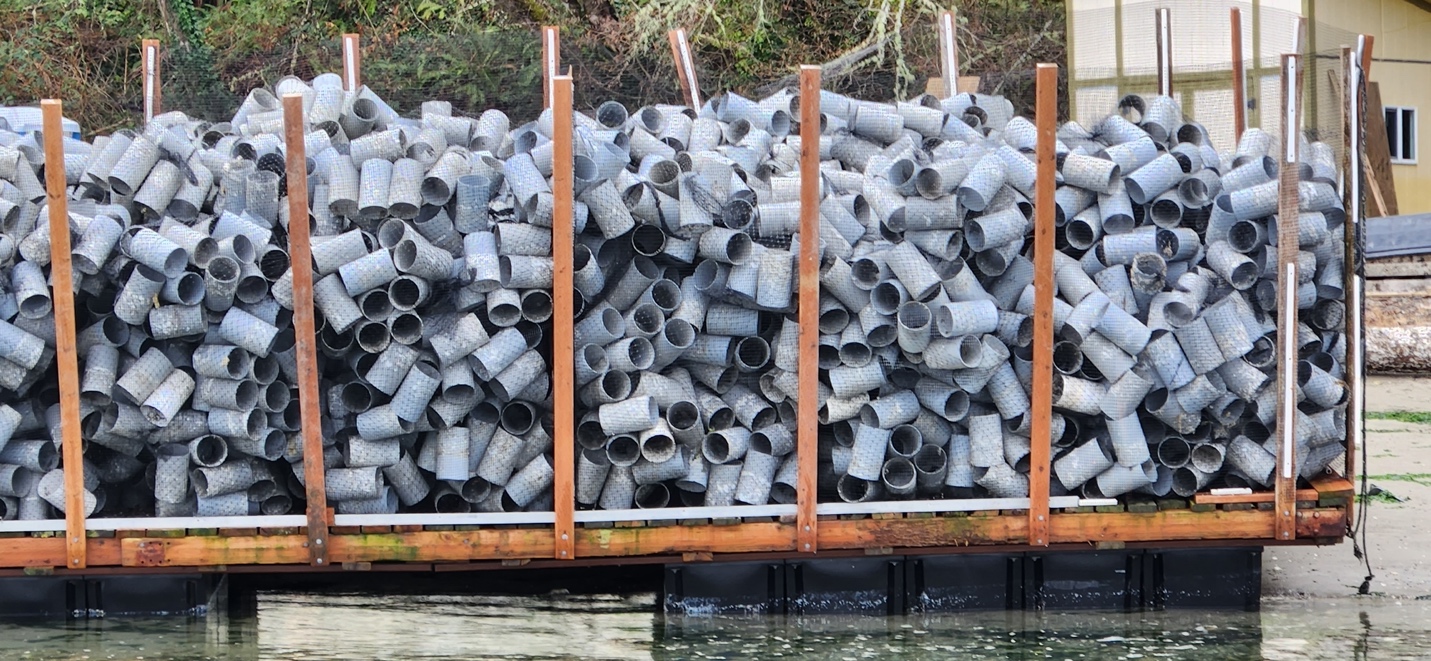
Barge with used geoduck tubes stored in Henderson Inlet for months
Furthermore, any lost tubes washed onto shore away from the monitored site may be exposed for years. Residents in the area of shellfish farms often have a collection of such gear that has washed up.
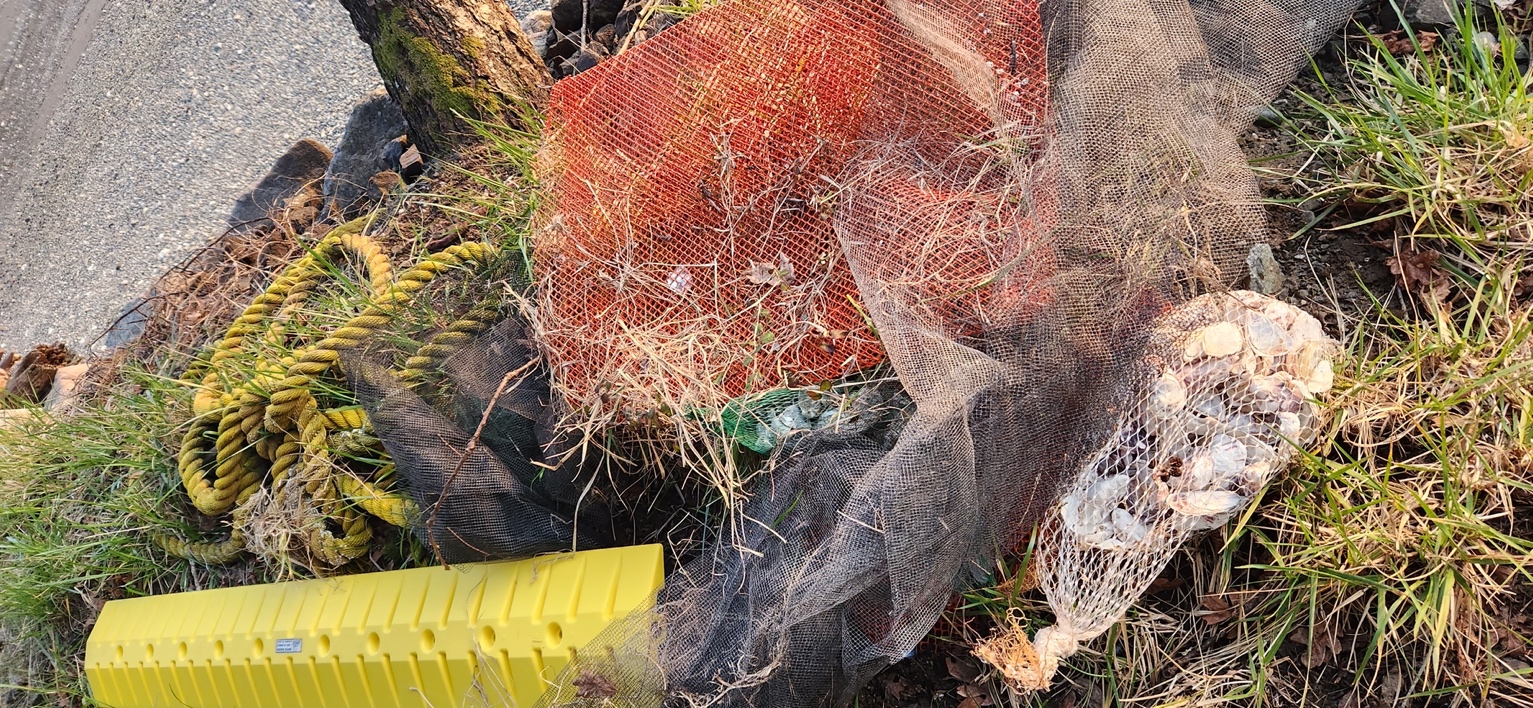
Plastic debris washed up on the beach at Ron Smith’s residence
There is no consideration given for the effect of mechanical abrasion on the plastic. If you have any doubt about the harshness of the beach environment, all you have to do is try to walk barefoot on the beach in question. The substrate shifts constantly. On my nearby beach, I have seen the volume of gravel change by as much as 1 foot in depth in as little as a week.
The authors of this plastics paper make the argument that the presence of plastic debris in the environment from sources other than aquaculture makes the placement of the shellfish industry’s plastic irrelevant. It is the argument that is irrelevant.
Item 1.4 – “Microplastics have not been shown to affect Puget Sound biota”.
Seriously? Do a quick web search for science articles about the effect of microplastics on marine life and you will be overwhelmed by the number of articles. There are now studies out showing it to be a global problem, and all of our estuaries are impacted.
https://www.ncei.noaa.gov/news/tracking-global-marine-microplastics
I do agree with the authors that polystyrene spheres are not the most common polluting form. However, while discounting spheres because they are not the breakdown product of their plastic, they ignore the capacity for their plastic to degrade into microfibers, which is the most common form of plastic pollutant. While arguing that our Puget Sound waters are still relatively clean compared to some other places in the world, they seemed to think that adding to the problem is alright. It is not.
Item 1.5 – “Use of rigid PVC tubes do not pose a toxic hazard.” In this section, the authors state that the PVC pipe used by the shellfish industry contains no phthalates, but offer no reference to the actual pipe used or the chemical constituents of that pipe. There are numerous additives in all PVC pipe. Should they not submit documentation of what they intend to use? Should we accept this statement at face value as if from an uninterested party? Wikipedia states that it (PVC) “always requires conversion into a compound by the incorporation of additives such as heat stabilizers, UV stabilizers, plasticizers, processing aids, impact modifiers, thermal modifiers, fillers, flame retardants, biocides, blowing agents, smoke suppressors and (optionally) pigments.” How many of these additives are used in their pipe? Are we supposed to believe that they commission a special pipe low in some additives because of their marine use? They do not say so, but in some documents (DEIS Burly Lagoon 2023) they claim to use “marine grade” plastic. I have tried doing a web search for “what is marine grade PVC”. See for yourself. You will find no coherent description of this as a special product, and it seems to be simply Schedule 40 PVC.
Item 1.6 – “HDPE gear also does not pose a toxic hazard.” They state “few studies” as being available, but go on to state 1.6% loss of HDPE by weight in 12 months. Let’s just do the math. So, it’s OK to put plastic in the beach that leaches 13,245 pounds of chemicals and/or microplastics in a year? How can this be a serious argument? Their final line is “Lack of degradation of HDPE gear is supported by the decades of use of aquaculture cages reported by Puget Sound growers.” No science there, but a clear admission of intent to keep using the product in spite of evidence that it degrades.
Item 1.7 – “Microplastics are not a major source of exposure to persistent organic pollutants (POPs).” The authors restate the known pathway of migration of microparticles which have an affinity for POPs, and then assert that because POPs are absorbed into sediments that it somehow doesn’t matter. And, they say that there really isn’t any good data anyway. What is important here is that marine organisms ingest microplastics, which have an affinity for POPs, thereby incorporating them into their tissues. As this moves up the foodchain, it eventually reaches the top of the chain which includes humans and orcas. If POPs are also absorbed into sediments, it doesn’t make the foodchain problem any better. Their argument is irrelevant and only distracts from the main issue.
The conclusion of the paper continues to systematically mis-state the facts. I would rewrite the conclusion thus:
Aquaculture operations are a significant source of marine plastic pollution and, although the products used are fairly robust, they do degrade. Based on the massive bulk of plastic imbedded in the beach and the extended lifespan of its use, degradation is inevitable, and the amount of microplastics added to the environment is highly significant. The argument that, because the larger portion of marine plastic pollution is secondary from terrestrial sources, makes the intentional addition of many tons of plastic to our waters (even intermittently) absurd.
And, as to the effect on Puget Sound biota as being negligible, there is growing alarm in the scientific community about the dangers of microplastics. The advocates for plastic use in the marine environment would rather wait until the impacts are obvious to everyone. When the impact on marine biota is widespread, it will be too late. The opinion of the European Union in a recently published 300 page study suggested a “precautionary” approach.
https://op.europa.eu/en/publication-detail/-/publication/e9e7684a-906b-11ec-b4e4-01aa75ed71a1
It would seem the logical thing to do to wait for more data and restrict marine use of plastics until they can be shown to be safe.
If you wish to read more about the threat of plastic in our environment, please visit
https://protecthendersoninlet.org/the-threat-of-plastics-in-our-environment/
where there is a more general discussion.
Respectfully submitted on behalf of Protect Henderson Inlet, non-profit organization
Ron Smith
President
www.ProtectHendersonInlet.org
